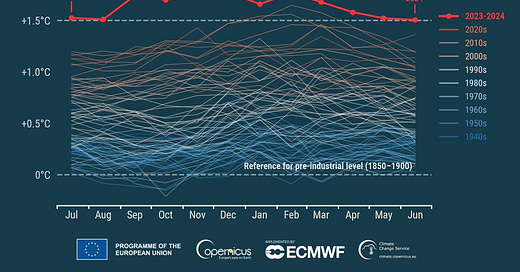Today, the Swiss Re Institute announced that estimated insured losses from natural catastrophes are on track to exceed USD 135 billion in 2024.
The reinsurer found that at least two-thirds of those losses are attributable to the US: Two major hurricanes, Helene and Milton, made landfall on the coast of Florida in September and October this year. Insured losses from both hurricanes are expected to approach USD 50 billion.
The year 2024 also experienced a high frequency of severe thunderstorms (severe convective storms, or SCS), which mainly affected the US. Insured losses from SCS are expected to add more than USD 51 billion globally for 2024.
Major floods hit Europe and the Middle East, causing estimated insured losses of close to USD 13 billion as of today.
I shared the press release this morning on social media, but I’m mentioning some of these findings again since I looked at the news from week 26 this year. Today, we are midway through the 52 days of looking back at each week of 2024: the week of June 24-30 (also see graph above). That week is a good example of how extreme the weather worldwide has become and how little we read about it in the news. Under the heading “Global Heatwave,” the publication summed up extremes worldwide.
To summarize: There were extended and severe heatwaves in northwest India. Delhi recorded its highest-ever minimum temperature when night-time temperatures did not drop below 35.2C. In China, extreme weather continued that week, including deadly torrential rain and drought conditions. In the Middle East, more than 1,000 hajj pilgrims reportedly died amid the scorching heat of 51.8C in the holy city of Mecca in Saudi Arabia.
Meanwhile, tens of millions of people in the US were under dangerous heat warnings in week 26 as some cities faced record-breaking temperatures. About 80% of the country’s population was experiencing a heat dome, which brought prolonged periods of temperatures above 32.2C.
There were two main stories in 2024. One is of climate extremes; the other one is even worse: a worldwide weakening commitment to take climate action.
Today, Oliver Milman wrote about it in The Guardian: “An unprecedented year of elections around the world has underscored a sobering trend – in many countries the commitment to act on the climate crisis has either stalled or is eroding, even as disasters and record temperatures continue to mount.”
Every day, we share photos in the chat that tell another story. These photos show beauty and joy; I’m not complaining. We should appreciate the good life and beautiful planet to better understand the threats we face. It gives us the motivation and hope we need to do better.
When asked about the recent COP 29 outcome, former US Vice President Al Gore answered with a similar hope: “Ultimately, coming out of COP 29, we must transform disappointment into determination. We can solve the climate crisis. Whether we do so in time to meet the goals of the Paris Agreement will depend on what comes next.”
More photos in the chat.
Notes:
https://www.swissre.com/press-release/Hurricanes-severe-thunderstorms-and-floods-drive-insured-losses-above-USD-100-billion-for-5th-consecutive-year-says-Swiss-Re-Institute/f8424512-e46b-4db7-a1b1-ad6034306352
https://www.theguardian.com/environment/2024/nov/23/election-climate-change-far-right










Tragically, there is no commitment from leadership to reverse or even stop the progress of climate chaos. We are still making noise.
Off to look at more lovely, soothing images.
To have rainbows we will have to be able to stop the rain…
The seasons are running and the colours are still suspended between worn canvases and new artists. We have the space, the walls, we just need the masterpieces.